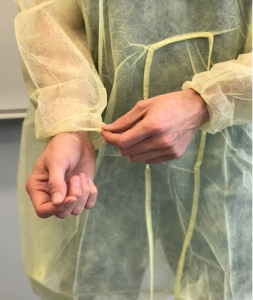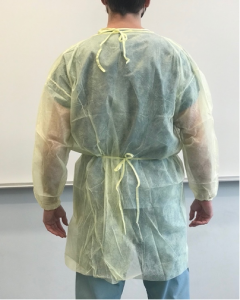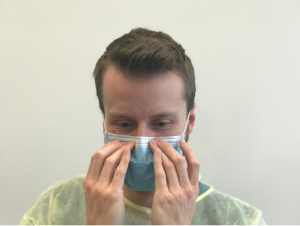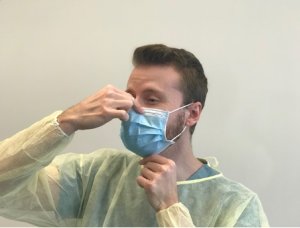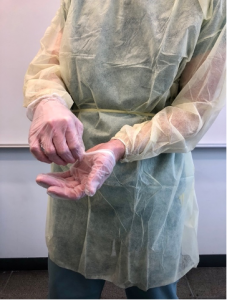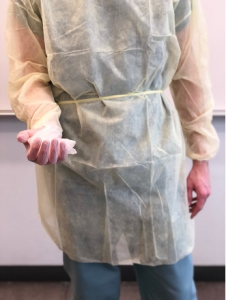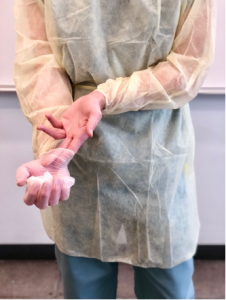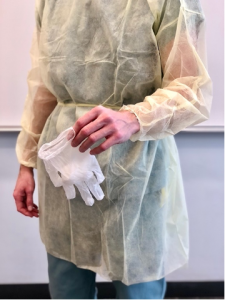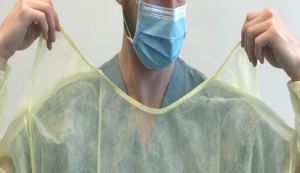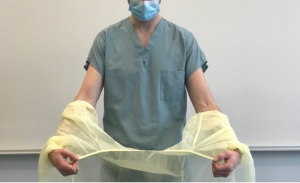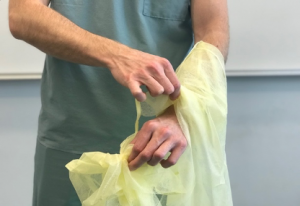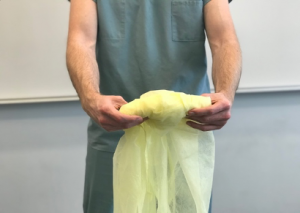Putting it All Together: Putting on and Taking Off Full PPE
All PPE should be put on in a specific order to ensure the skin, nose, mouth, and eyes are covered to prevent transmission of infection to healthcare providers. Depending on the type of additional precaution or risk assessment, a gown, goggles, face shield, and mask (e.g., medical or N95) may be used during client care. The order for removing PPE should be carefully followed to prevent recontamination of the healthcare provider (PIDAC, 2012). It’s also important to remember that when gloves are removed first, the hands must only touch uncontaminated surfaces of the gown such as the neckline of the gown behind the neck and at the back of the shoulders. The gown then needs to be peeled down away from the body and the arms. Review Putting it All Together, including the interactive videos and descriptive videos for steps to take when putting on and removing PPE and to prevent recontamination.
Putting it All Together: Putting On and Taking Off Full PPE
Safety considerations:
- The selection of PPE is based on the nature of the interaction with the client and the likelihood of transmission of infectious agents. See how to select PPE using the principles of risk assessment in Chapter 1.
- PPE should be put on just prior to the interaction with the client and should be removed immediately after the interaction, followed by hand hygiene.
Remember that clients may feel depressed or lonely when isolated in a room or experiencing decreased contact with healthcare providers. Support for individuals in isolation must be provided. Conversely, some clients may appreciate the privacy of an individual room.
Putting On Full PPE
Steps |
Additional Information |
1. Make sure hair is tied up and off shoulders and/or headwear (e.g., hijab, kipper, turban, taqiyah) is secured, and excess material tucked into your uniform. |
 |
2. Remove rings, bracelets, pendants, and watches. Ensure that nails are short. |
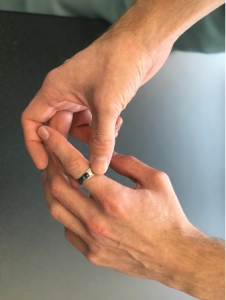 |
3. Perform hand hygiene. |
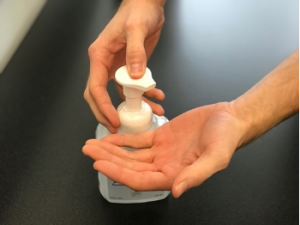 |
4. Apply gown.Remove the gown in a manner that does not touch clothing or the floor.Unfold gown.Securely tie or Velcro at the neck and waist.Pull sleeves down to wrists.Ensure that the back is covered by the gown. |
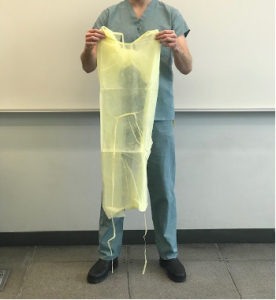
|
5. Apply a mask.Secure ties, loops, or straps around head or ears.Secure the metal band around the nose.Pull mask over chin as required. |
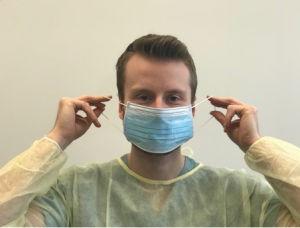
|
6. Apply goggles or face shield.Adjust fit of goggles.Goggles can be worn over prescription glasses.Face shield should fit over the brow. |
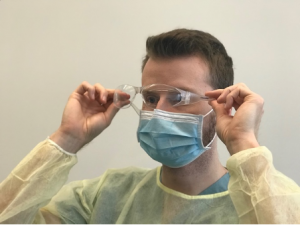
|
7. Select the appropriately sized gloves from the box, taking care that only the gloves required are touched. Most gloves are not hand-specific. |
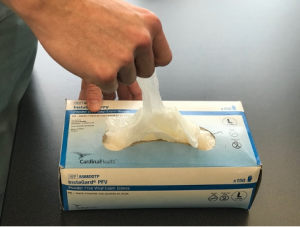 |
8. Take care not to puncture or tear gloves while donning, and apply non-sterile gloves over top of the cuff of the gown. |
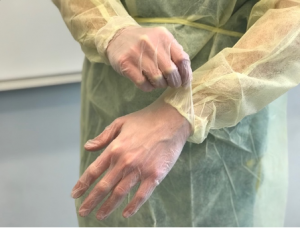 |
9. Ready to provide care. |
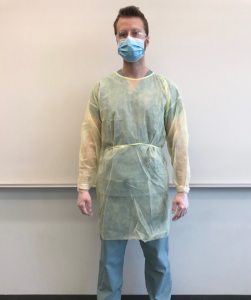 |
Source: PIDAC, 2012. |
Taking Off Full PPE
Steps |
Additional Information |
1. Remove gloves using glove-to-glove and skin-to-skin technique.Grasp the outside edge of the glove on the inside of the wrist, taking care not to touch skin.Peel the glove off completely by rolling the glove inside out, and hold onto the removed glove in the palm of the remaining gloved hand.Insert two fingers of the ungloved hand under the cuff on the inside of the wrist of the gloved hand.Pull off the second glove by turning it inside out. |
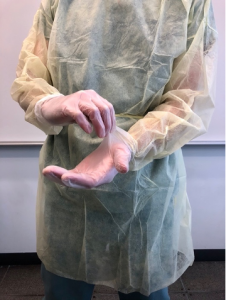
|
2. Dispose of gloves into the appropriate receptacle.Note: Public Health Ontario suggests removing the gown next. However, other healthcare sources (e.g., British Columbia Centre for Disease Control, Centre for Disease Control, World Health Organization) recommend performing hand hygiene before removing the gown. |
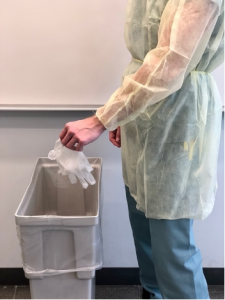 |
3. Remove gown in a manner that does not contaminate clothing.Untie at the waist, then untie at the neck.From the neck ties, pull the gown forward and, turn the gown inward, and roll down into a ball. Make sure the gown does not touch the uniform and do not to touch the bottom of the gown.Discard gown into an appropriate receptacle. |
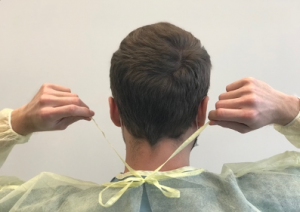
|
4. Perform Hand Hygiene.Always perform hand hygiene after removing the gown as hands may have been contaminated upon removal of the gown. |
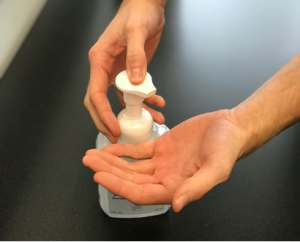 |
5. Remove eye protection or face shield.Arms of goggles and the headband on the face shield are considered clean. Handle these only by the sides. The front of the face shield or goggles is considered contaminated.Dispose or clean according to agency policy. |
 |
6. Remove mask.Ties, earlobe loops, or straps are considered clean and may be touched. If tied, remove bottom tie first, then top tie.Remove ear loops or straps by leaning forward to allow the mask to slip off your face. |
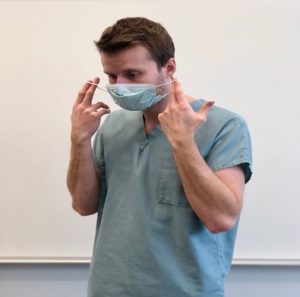 |
7. Dispose of the mask in the garbage bin. |
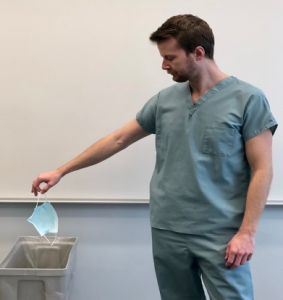 |
8. Perform hand hygiene as this step reduces the transmission of microorganisms. |
 |
Source: PIDAC, 2012. |
Points of Consideration: Use and Disposal of PPE
Protocols regarding PPE have changed since the COVID-19 pandemic. Public Health Ontario (2021) provides updated guidelines to inform healthcare providers of the minimum expectations regarding PPE.
The guidelines address PPE requirements for inpatient facilities, ambulatory and outpatient facilities, and other settings which include long-term care (Public Health Ontario, 2021). Healthcare providers need to refer to and follow PPE protocols specific to their healthcare setting. Infection prevention and control protocols are specific to the type of care you provide to a client, the client’s diagnosis, and according to the policies of the healthcare facility.
Protocols can vary between sites, units within each site, and the care being provided to the client. For example, in long-term care, Public Health Ontario (2020b) recommends the following guidelines when PPE is limited:
Masks:
- Universal masking.
- Extended use of masks when supply is limited:
- Use for an extended period of time.
- Reuse if not visibly soiled, wet, or physically damaged.
- Need to be handled to minimize cross-contamination.
Gowns:
- Bundling activities to decrease the need to change the gown.
- Cohorting clients with the same diagnosis.
- Reuse if not visibly soiled, wet, or physically damaged.
Eye Protection:
- Single user for eye protection equipment.
- Disinfect outward layer when soiled.
- Discard once damaged, visibly soiled, or decreased visibility due to excess disinfecting.
Gloves:
- Should always be single-use only and task-specific to avoid inappropriate use.
Remember to always perform a risk assessment prior to care and follow the 4 Moments of hand hygiene. With all PPE, follow manufacturer’s instructions and the healthcare facility’s policies regarding extended and reuse.
To learn more about the specific PPE requirements for long-term care, review Public Health Ontario. (2020). COVID-19 webinar — Healthcare worker personal protective equipment (PPE) use and cohorting in long-term care and retirement homes. [Webinar]. https://www.publichealthontario.ca/-/media/event-presentations/covid-19-webinar-healthcare-worker-ppe-use-cohorting-ltcrh.pdf?la=en
Watch the following video that demonstrates and explains each step of how to put on full PPE:
Test Yourself!
While watching the interactive video about putting on PPE, apply what you have learned by answering the questions throughout the videos. Please note: there is no sound in these videos.
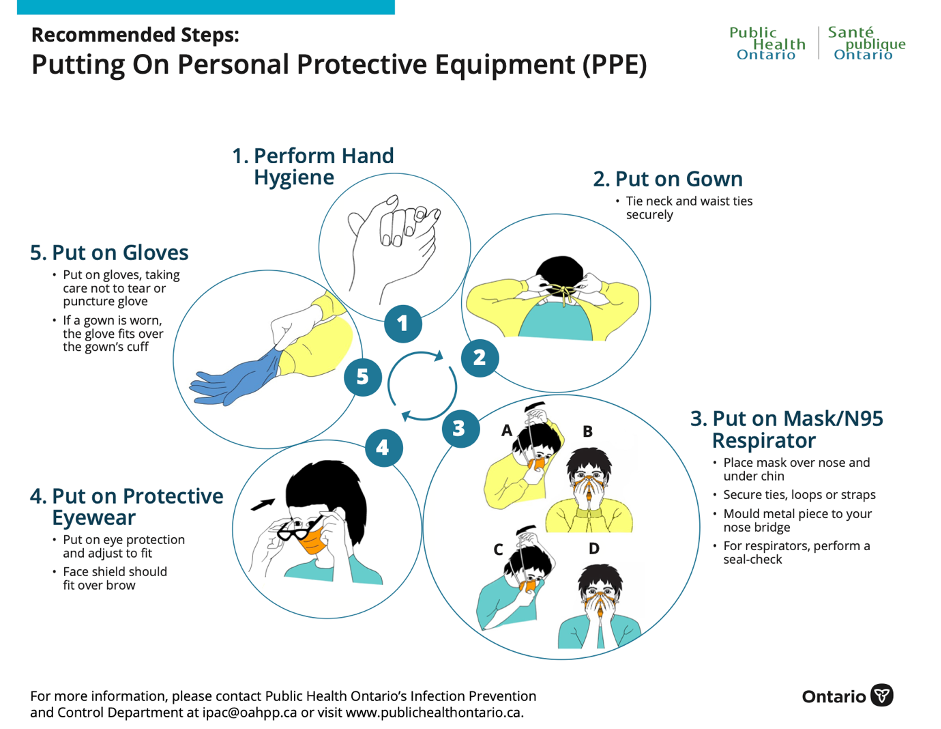
Watch the following video that demonstrates and explains each step of how to take off full PPE:
Test Yourself!
While watching the interactive video about taking off PPE, apply what you have learned by answering the questions throughout the videos. Please note: there is no sound in these videos.
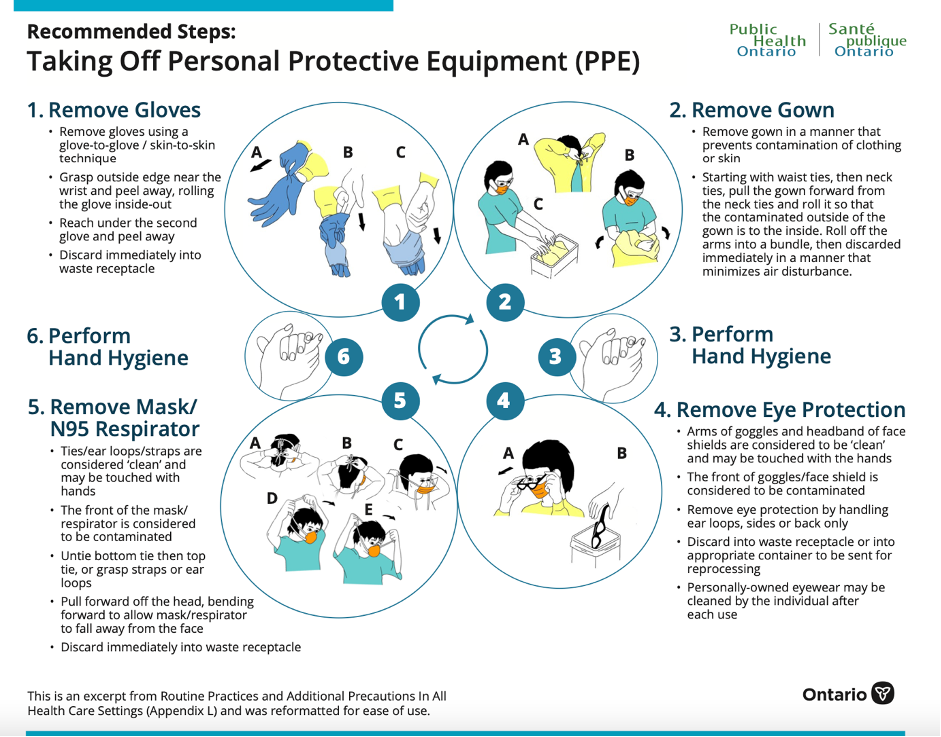
Watch the following video that demonstrates and explains how to put on and take off full PPE:
Attribution
This page was remixed with our own original content and adapted from:
Clinical Procedures for Safer Patient Care — Thompson Rivers University Edition by Renée Anderson, Glynda Rees Doyle, and Jodie Anita McCutcheon is used under a CC BY 4.0 Licence. This book is an adaptation of Clinical Procedures of Safer Patient Care by Glynda Rees Doyle and Jodie Anita McCutcheon, which is under a CC BY 4.0 Licence. A full list of changes and additions made by Renée Anderson can be found in the About the Book section.
Infection Prevention and Control Practices by Michelle Hughes and Kendra Allen is licensed under a Creative Commons Attribution 4.0 International License, except where otherwise noted.

